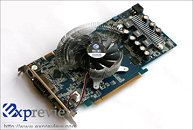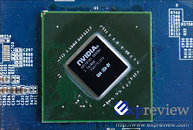Tuesday, February 10th 2009

Galaxy GeForce 9600 GT Green Edition Pictured
The GeForce 9600 GT Green Edition is NVIDIA's newest SKU that is based on an energy-efficient variant of the GeForce 9600 GT graphics processor. The SKU maintains the G94 GPU design, except for that it is built on the newer 55 nm silicon process (model: G94-350-B1), that is expected to add to its energy efficiency, also that the GPU makes do with a lower core voltage of around 1.0V from its original 1.1V figure on the 65 nm variant. At its default voltage setting the GPU uses reference clock speeds of 625/1625/900 MHz (core/shader/memory).
Galaxy designed its first accelerator based on the new GPU, to which it added its own set of innovations. The card uses a jumper to allow users to manually set the GPU voltage. At its default state (pins 1-2 short), the GPU operates at 1.0V, but when pins 2-3 are short, the GPU voltage enters a "pressurized state" (increases). When the jumper is removed (neither pins short), the GPU voltage plummets to 0.8V. The Galaxy accelerator needs the 6-pin PCI-E power connector for operation. The GPU is cooled by a classic Zalman VF703 Al cooler, while the memory is passively cooled under its air-flow.
Source:
Expreview
Galaxy designed its first accelerator based on the new GPU, to which it added its own set of innovations. The card uses a jumper to allow users to manually set the GPU voltage. At its default state (pins 1-2 short), the GPU operates at 1.0V, but when pins 2-3 are short, the GPU voltage enters a "pressurized state" (increases). When the jumper is removed (neither pins short), the GPU voltage plummets to 0.8V. The Galaxy accelerator needs the 6-pin PCI-E power connector for operation. The GPU is cooled by a classic Zalman VF703 Al cooler, while the memory is passively cooled under its air-flow.



10 Comments on Galaxy GeForce 9600 GT Green Edition Pictured
Comparing this to the HD4670 isn't exactly fair, as this handily outperforms the HD4670. Of course it will use more power, it is a more powerful card.
Likely, with the GPU running at 1.0v, the extra power from the 6-pin power connect is not really needed, I believe the 9600GT is already on the edge of even needing that connector. Howerver, it is still required on this card because the option to run the card at stock voltages is still there, so that power still might be required.
I'd like to see what clock speeds are possible with the card running at 0.8v personally, and what kind of power consumption it has. I have a feeling this card would put up power consumption numbers close to that of the HD4670 with performance numbers matching the HD4670 also at these settings.
It seems this card actually fills a large market. If you like overclocking, the 55nm card and upgraded cooling should be a bonus, and the ability to run the card at 1.1v is nice. If you want a decent HTPC card, running the card underclocked at 0.8v should give you decent performance, with lowered power consumption, and keep the fan quiet. If you just want a decent card at stock, running it at 1.0v would and leaving it be would still give decent performance with a power savings over the original 9600GT.
it reminds me on the power switch on my 486 with 33 or 66mhz ;-P
So, as a rough estimate, a 0.1 volt drop might mean a 15% - 17% heat output decrease.
Don't quote me on that, though!
However, I just don't see the point of this card. Once I learn to use NiBitor, I can do this to my 9600 GT for $0! (And just wait until I get around to finding maximum overclock... :D)
From early testing the adoption of "power efficient" GPU(I think you guys should know what actually this more "Power efficient" GPU is ;)), results in 8 degress lower under full loading using the same cooling fan, not a bad result indeed.